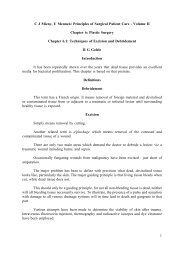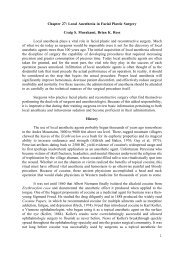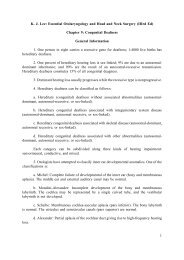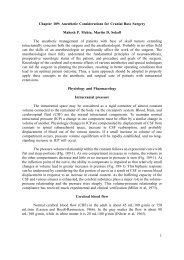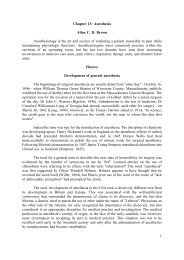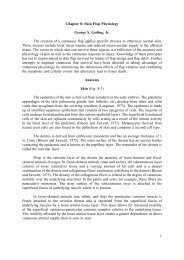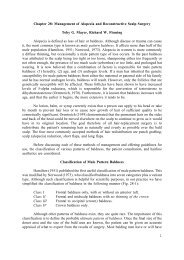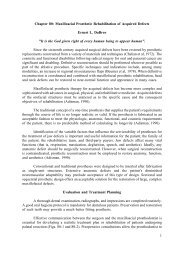1 Chapter 99: Congenital Disorders of the Larynx ... - Famona Site
1 Chapter 99: Congenital Disorders of the Larynx ... - Famona Site
1 Chapter 99: Congenital Disorders of the Larynx ... - Famona Site
Create successful ePaper yourself
Turn your PDF publications into a flip-book with our unique Google optimized e-Paper software.
perichondrium and even into surrounding tissues between <strong>the</strong> tracheal rings and beyond <strong>the</strong><br />
trachea, showing <strong>the</strong> possibility <strong>of</strong> regrowth after treatment. The more extensive lesions may<br />
require an alternate treatment plan. About half <strong>of</strong> <strong>the</strong> patients have cutaneous hemangiomas<br />
<strong>of</strong> <strong>the</strong> head, face, or neck, but no correlation exists with <strong>the</strong> site <strong>of</strong> <strong>the</strong> laryngeal lesion. All<br />
patients have some form <strong>of</strong> respiratoy distress, usually variable and fluctuant. The clinical<br />
features are more clearly defined as inspiratory stridor (intermittent at first and <strong>the</strong>n<br />
persistent), harsh "barking" cough, altered cry or hoarseness, and failure to thrive. An initial<br />
erroneous diagnosis <strong>of</strong> croup is <strong>of</strong>ten made. A 2:1 female-to-male preponderance exists. Most<br />
cases appear by 6 months <strong>of</strong> age.<br />
Diagnostic evaluation<br />
Lateral radiographic study <strong>of</strong> <strong>the</strong> upper airway shows subglottic s<strong>of</strong>t tissue swelling<br />
and usually clearly demonstrates a subglottic abnormality consistent with hemangioma (Fig.<br />
<strong>99</strong>-22).<br />
Diagnosis is made by endoscopic examination. The appearance is sufficiently<br />
characteristic for an experienced observer to make a macroscopic diagnosis without biopsy,<br />
especially if <strong>the</strong>re are associated cutaneous hemangiomas. The lesion is usually localized to<br />
<strong>the</strong> subglottic region on one side, as a sessile, fairly firm, and compressible pink, red, or<br />
bluish lesion that is poorly delineated from <strong>the</strong> surrounding tissues. A biopsy may be<br />
performed when <strong>the</strong> diagnosis is uncertain, with precautions taken to maintain <strong>the</strong> airway in<br />
<strong>the</strong> unlikely event <strong>of</strong> excessive bleeding. Although infantile subglottic hemangioma has<br />
generally been regarded as a unilateral lesion, this is not always so. With modern anes<strong>the</strong>sia<br />
and sophisticated endoscopic techniques using magnification, an exact evaluation <strong>of</strong> <strong>the</strong> site<br />
and distribution <strong>of</strong> <strong>the</strong> lesion can be made. Classification <strong>of</strong> congenital laryngeal<br />
hemangiomas by anatomic site (Benjamin and Carter, 1983) includes lesions that are<br />
unilateral, bilateral, unilateral with posterior extension, and upper tracheal (Fig. <strong>99</strong>-22).<br />
Management<br />
The airway obstruction is usually severe and life threatening. Some patients have acute<br />
obstruction and require immediate relief, ei<strong>the</strong>r by a tracheotomy performed at <strong>the</strong> time <strong>of</strong><br />
diagnosti endoscopy or by temporary intubation followed later by a tracheotomy. Most cases<br />
require a tracheotomy both for <strong>the</strong> patient's safety and to enable treatment to be performed.<br />
Many forms <strong>of</strong> treatment have been advocated. They include tracheotomy and no<br />
active treatment, awaiting spontaneous regression; temporary, intermittent, or prolonged<br />
endotracheal tube intubation with or without steroids; injection <strong>of</strong> sclerosant; or injection <strong>of</strong><br />
intralesional steroids for prolonged or repeated periods; excisional surgery; cryosurgery;<br />
external beam irradiation; or laser endoscopic surgery or endoscopic placement <strong>of</strong> a<br />
radioactive gold grain. Because <strong>of</strong> <strong>the</strong> relatively small numbers <strong>of</strong> patients treated and <strong>the</strong><br />
varying attitudes to <strong>the</strong>rapy, controlled studies have not been possible.<br />
Success has been repeated with each <strong>of</strong> <strong>the</strong> various modalities <strong>of</strong> treatment outlined<br />
above, but generally, expectant treatment, steroid treatment, or laser excision is favored.<br />
Radiation <strong>the</strong>rapy has previously been an acknowledged, reliable treatment used for many<br />
years to achieve resolution <strong>of</strong> <strong>the</strong> lesion and removal <strong>of</strong> <strong>the</strong> tracheotomy tube. A tracheotomy<br />
28




